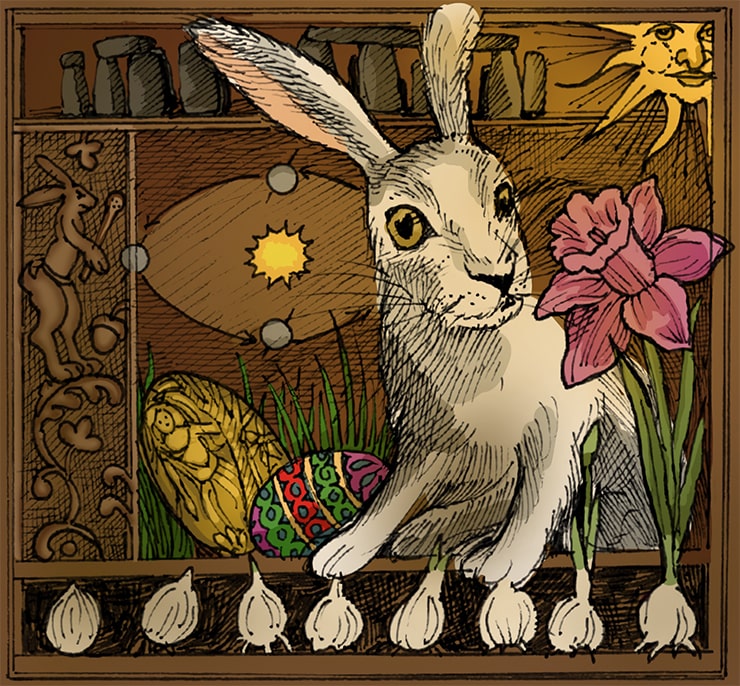The Earth is askew.
Our planet is tipped sideways, an off-kilter condition that my granddad would have described as cattywampus.
I know this for a fact because I see the effects every year from my back porch.
In summer the sun sets due west of us over Lake Champlain and spends most of the afternoon shining in our kitchen windows—and, incidentally, spends the lion’s share of the day scattering rays on the garden. In Winter it sets way to the south down past the Alburgh bridge and barely shines on us at all. The reason we have to start our tomato seedlings under grow lights is because the Earth—unlike decent straight-up-and-down planets like Mercury or Venus—lolls back on its axis to the tune of 23.4 degrees.
That axial tilt is the reason why Vermont is freezing in February. Seasons are the fault of tilt. Tilt, in seasonal order as the Earth revolves around the sun, gives us crocuses, zucchini, red leaves, and snowmen. It makes for an interesting planet, but—at least in our sun-deprived household—it has awful effects on infant vegetables and houseplants.
The annual return of the sun in Spring after the cold, dark Winter historically has always been a big deal. After the Winter solstice on December 21st—the shortest day of the year—each successive day packs on an extra two minutes or so of sunlight, heading toward the Spring equinox, when day and night are of equal length. In Celtic tradition, the Spring equinox is dedicated to the fertility goddess Ostara, whose sacred animal was the hare—from which, eventually, evolved the far more approachable and cuddly Easter bunny. Perversely, hare hunting was a popular Easter activity in medieval England—which just seems wrong, given the hare’s exalted antecedents. Occasionally, however, the medieval bunny apparently turned the tables: the Smithfield Decretals, a gorgeously illuminated 13th-century manuscript with text by Pope Gregory IX, includes a picture of retaliatory rabbits armed with bows, arrows, and clubs hunting people.

In Iran, Afghanistan, and Pakistan, the Spring equinox marks the festival of Nowruz, the beginning of the new year. Celebrants grow dishes of wheatgrass, leap over bonfires, eat cookies, and play buzkashi—a game on horseback similar to polo, except that a goat carcass is used in lieu of a ball. Druids flock to Stonehenge on the equinox to watch the sun rise over the Heel Stone. And in Poland—which apparently has a climate much like that of northern Vermont—kids make straw effigies of Marzanna, the Winter goddess, and either set her on fire or throw her in the river.
This last is a rite I can get my head around. By the spring equinox here, the lake is still frozen; there’s still snow on the ground; everybody’s sick of wearing boots; and we’re all more than ready to torch Marzanna and dance on her ashes. We want some sun.
Sunshine, researchers tell us, has a bevy of biological and psychological bennies. It makes us cheerfuller, reduces stress, and cuts the risk of heart attacks, strokes, skin complaints, and certain cancers. It also alleviates aches and pains, improves memory, and—at least if you get up early enough in the morning to admire it—can even help us lose weight.
Deprived of sunshine, some of us get flat-out miserable. About 20 percent of people suffer from some form of seasonal affective disorder—a malady appropriately abbreviated as SAD—which is depression triggered by the dismal low light levels of winter. Treatment generally is phototherapy, which involves sitting next to a box that gives off a bright light that mimics sunshine. An alternative cure, if you can afford it, is a long vacation in the Bahamas.
The biological effects of sunshine are largely due to vitamin D—famous for promoting the health of bones, but also important for a wide range of essential activities involving an enormous number of genes. Nicknamed the “sunshine vitamin,” D is produced when ultraviolet B (UVB) rays from sunlight hit our skin. In Summer, when we’re all running around outside in shorts, producing enough D to keep us going is a piece of cake. In the Winter, when we’re bundled up to the eyeballs and there’s no sun in sight, it’s next to impossible.
According to Harvard Health Publishing, when it comes to vitamin D, anybody living north of the 37th parallel—that is, above the latitude of Richmond, Virginia—is pretty much out of luck during the cold months. The solution, scientists tell us, is to stop whining, eat fatty fish, and take vitamin pills.
Still, there’s a lot more to sun than vitamin D—and even more to it than the fact that it makes our gardens grow.
In the later days of the Roman Empire, the sun god was known as Sol Invictus—the Invincible Sun. He was the patron of soldiers, who hoped for similar invincibility; and his festival was celebrated on or about December 25, as the days once again began to lengthen—proving that Winter was on its way out and there was no defeating the sun.
The annual return of the sun, as long as there have been people to watch for it, has been a sign of hope and joy, an affirmation that we’ve lived through the worst and a better future is just around the corner.
The lesson of the returning sun is that the bleak days never last forever. The good—even though it sometimes seems a long time coming—is invincible. ❖



